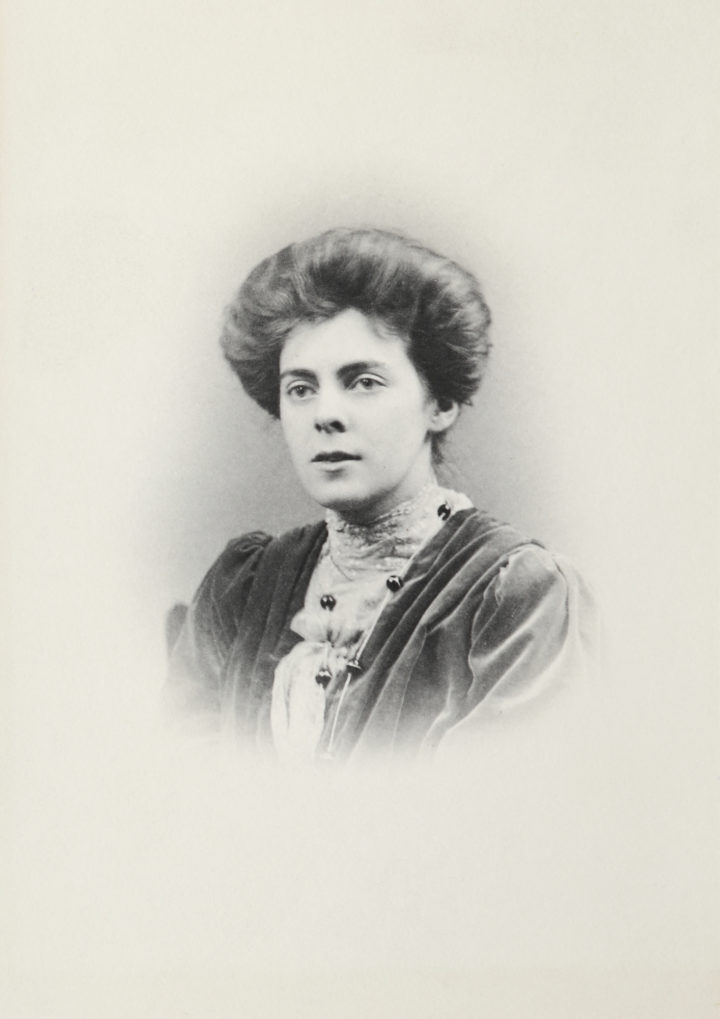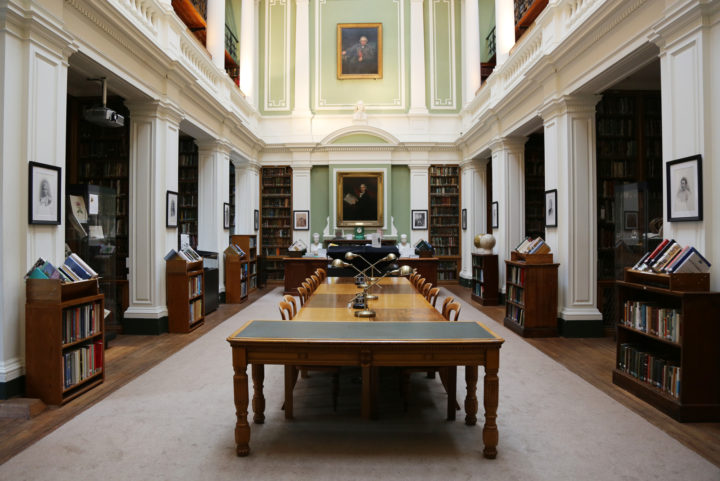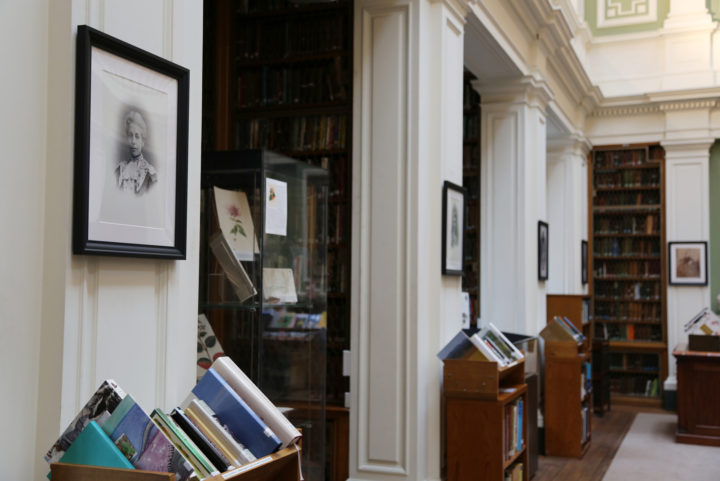Celebrating the Linnean Society's First Women Fellows
A portrait exhibition celebrating the lives and achievements of the first women to be admitted to Fellowship of the Linnean Society
Published on 27th March 2020

Looking at the walls of the Linnean Society's rooms in Burlington House, it would be easy to assume that women have played only a small part in its history and achievements. Among the many likenesses of our male Presidents, Fellows, and adopted heroes, only two portraits of women are on permanent view (Irene Manton, our first female President, 1973-1976, and Pleasance Smith, the wife of our founder).
This is a shocking imbalance, one that overlooks the profound contribution women have made to the intellectual life of the Society since its foundation, and in the 116 years since their first admission to Fellowship. It is an imbalance we have attempted to redress in an exhibition of photographic portraits in the Society's Library. Showcasing the first women to be admitted as Fellows, we hope to shed some light on their lives and achievements and, by extension, the contributions of women in science from all eras and backgrounds. The exhibition, which is mounted in the main reading room, uses original carte de visite photographs submitted by the subjects for their Fellowship applications. We hope you enjoy it!
Margaret Jane Benson (1859-1936)

Palaeobotanist, elected FLS 1904
Prof Benson’s speciality was the study of fossil plants, especially the process of chalazogamy (a specialised form of plant fertilisation).
She worked with D.H. Scott and F.W. Oliver (both prominent botanists), and published on several fossil ferns.
She had a distinguished academic career, gaining a DSc (1894), a Fellowship of Newnham College, Cambridge, and University College, London (1903), and becoming Head of Botany at what was then Royal Holloway College (1893–1922) and Professor of Botany (1912). She supervised numerous doctoral students, and two of her protégés - Emily Berridge and Helen Gwynne-Vaughan - were among the first cohort of women Fellows.
She was 45 years old when elected to the Society and admitted in January 1905.
Grace Coleridge Frankland (née Toynbee) (1858-1946)

Microbiologist, elected FLS 1904
Grace Frankland’s maiden name was Toynbee, and there exists a direct family link to the Society’s premises in Wimbledon, Toynbee House (the street on which it sits being named for her father, Sir Joseph Toynbee FRS).
She does not seem to have had any formal education in microbiology but was recognised as working in partnership with her husband, Dr Percy Faraday Frankland (1882), son of the chemist Sir Edward Frankland. Jointly they published several books, and she was the sole author of Bacteria in daily life (Frankland, 1903), a popular science book.
She was 46 at the time she was elected. In 2019 the University of Birmingham initiated an annual Grace Frankland Memorial Lecture series to honour her contributions to science.
Annie Lorrain Smith (1854-1937)

Lichenologist, elected FLS 1904
A founder member of the British Mycological Society, she served twice as its President (1907 and 1917) and on the Linnean Society’s Council (1918 -1921).
She worked at the then British Museum (Natural History) on fungi and lichens from 1892-1933, having studied under D.H. Scott at the Royal College of Science, who recognised her abilities. As women could not officially be employed at the Museum, for many years he arranged for her to be paid through an external source.
She published several major works on lichens, including her Monograph of the lichens found in Britain. Part II (1911), A Handbook of the British Lichens (1921) and Lichens (1921).
She was awarded an OBE in 1934 and a Civil List pension in 1933 at the age of 77, retiring a year later.
She was a supporter of the women’s suffrage movement. She was 50 when elected to Fellowship of the Society and was admitted in January 1905.
Emma Louisa Turner (1866-1940)

Ornithologist, elected FLS 1904
We know little about Turner's background or education and she is best known as an ornithologist and bird photographer, being the first female honorary member of the British Ornithologists' Union and a Royal Photographic Society Gold Medal winner.
Much of her time was spent on Hickling Broad in Norfolk, where she lived in a houseboat of her own design, and in a hut on a small island in the south-east of the Broad that became known as "Turner’s Island". She also had a house in Girton, Cambridge.
She published a series of books on the birds of the Broads, and on garden birds.
She was 38 at the time of her election (among the younger women elected) and also among those admitted in January 1905.
Marian Sarah Ogilvie Farquharson (née Ridley) (1846-1912)

Botanist, nominated 1904 (blackballed); elected FLS 1908
Farquharson joined the Epping Forest and Essex Naturalists' club in 1881, age 35, presenting them with a herbarium of 35 British fern specimens (these probably the same as described in her 1881 book, A Pocket Guide to British Ferns).
On her marriage to Robert Francis Ogilvie Farquharson (laird of the 4,500-acre Haughton estate at Alford, Aberdeenshire) in 1883, she adopted an interest in Desmids (a type of algae). Before her marriage she had studied music in London, but ill-heath forced her to return to the family home at East Woodhay, near Newbury.
After her move to Scotland, she joined the Alford Field Club and East of Scotland Union of Naturalists’ Societies, publishing in their journals on mosses and ferns, and presented at the meeting of the British Association for the Advancement of Science (BAAS) held in Aberdeen in 1885. In 1885 she was elected the first female Fellow of the Royal Microscopical Society but, bafflingly, was prohibited from attending any meetings on account of her gender. In May 1890 her husband died of influenza, aged 66 (Marian being only 43).
By 1899 she had become involved with the Congress of the International Council of Women, and contributed to the Biological Sciences section of the Congress. On 18 April 1900 she petitioned the Royal and Linnean Societies that suitably qualified women should be eligible for election to full Fellowship with no restriction on their attendance at meetings. This was rejected on a technicality (the full story of her battle for the admission of women will appear in a forthcoming special issue of The Linnean).
After years of campaigning, the Linnean Society finally relented, and the first women were admitted in 1904; all except Farquharson, who was shamefully blackballed. A second nomination attempt in 1908 was successful, but Marian's health had since declined, and she died in 1912, aged 66, without being formally admitted to the Fellowship she had fought for.
Emily Mary Berridge (1872-1947)

Palaeobotanist and bacteriologist, elected FLS 1905
Her BSc in Physics was taken at Bedford College in 1898, and a DSc on fossil plants from Royal Holloway College followed. Her doctoral supervisor was Prof Margaret Benson, herself among the cohort of 1905, and featured above.
At 33 years old, Berridge was among the younger women elected to Fellowship at that time, and was one of the first women to read a paper before the Society, in November 1905.
From 1916 she worked at Liverpool University in the Thompson Yates Laboratory, identifying bacilli responsible for fever and dysentery among soldiers returning from fighting in Alexandria.
Between 1919 and 1920 she worked at Imperial College on the physiology and pathogenicity of plant disease bacteria. She would later set up the Botanical Research Fund for postgraduate students, and donated equipment and materials to Royal Holloway, her alma mater.
Helen Charlotte Isabella Gwynne-Vaughan (née Fraser) (1879-1967)

Botanist and Mycologist, elected FLS 1905
Having gained a BSc in Botany and Zoology from Kings’ College London in 1904, she was only 26 when elected to Fellowship in 1905 (the second youngest woman admitted). Like Emily Berridge (above), she then studied under Margaret Benson at Royal Holloway, with a DSc awarded in 1907.
Academic posts followed, as lecturer at University College Nottingham (later the University of Nottingham) and as head of the botany department at Birkbeck College.
In 1911 she married David Thomas Gwynne-Vaughan FRSE FLS (1871–1915), but was widowed in 1915.
From 1918 to 1919 she served in the Women's Army Auxiliary Corps and then as Commandant of the Women's Royal Air Force (WRAF). In 1919 she became the first woman to be awarded a military DBE (Dame Commander of the Order of the British Empire), and was made Dame Grand Cross of the Order of the British Empire (GBE) in 1929.
After the First World War she was appointed Professor of Botany at Birkbeck, and continued to work on fungal genetics, being awarded the Linnean Society’s Trail Medal in 1920.
A political activist, she stood unsuccessfully as a candidate for local and parliamentary elections in 1922, 1923 and 1925. She resumed her military career from 1939 to 1941, when she served as Chief Controller of the Auxiliary Territorial Service (ATS).
Dorothea Frances Matilda Pertz (1859-1939)

Plant Physiologist, elected FLS 1905
Pertz spent much of her youth in Berlin and Florence, but also met many prominent naturalists on family visits to England.
In 1882 she was admitted as a student to Newnham College, Cambridge, graduating in 1885. However women were prevented from obtaining full degrees from the University at that time, and Pertz was only able to take her MA much later, in 1932. Women would not be admitted to full degrees and status at Cambridge University until 1947.
From 1892 to 1912 she worked in Cambridge with Francis Darwin on plant physiology (publishing five papers with him), and also with William Bateson (famous as the first biologist to use the term "genetics" to describe the study of heredity). She also published two papers as a sole author, unusual for a female scientist at that time.
After Francis Darwin’s retirement she gave up botanical research, but worked on indexing German literature on plant physiology. She was 46 years old at the time of her election to Fellowship.
Edith Rebecca Saunders (1865-1945)

Botanist & Plant Geneticist, elected FLS 1905
A plant anatomist and geneticist, she studied for the Natural Sciences tripos at Newham College, Cambridge from 1884 to 1888. She was appointed Demonstrator at the Balfour Biological Laboratory for Women between 1888 and 1890, later becoming Director of Studies at Girton College (1904–1914) and Newnham College (1918–1925).
She was 40 at the time she was elected to Fellowship of the Linnean Society and was awarded the Royal Horticultural Society's Banksian Medal in 1906.
She served on the Council of Linnean Society from 1910 to 1915, and was a Vice-President in 1912/1913.
She was President of the Genetical Society from 1936 to 1938.
Dr Marie Charlotte Carmichael Stopes (1880-1958)

Palaeobotanist, elected FLS 1909
The name of Marie Stopes is now associated with the birth control clinics that still carry her name, but it was her studies in palaeobotany that began her academic career.
Hers was a life of remarkable "firsts": the first woman to obtain a University of London joint BSc(Hons) degree (in just two years); the first female PhD in botany at the University of Munich ; the youngest woman to be granted a DSc degree in the UK; the first female lecturer in science at Victoria University, Manchester; the first female western scientist to visit Japan; and the first woman to set up a birth-control clinic in the British Empire. In addition, she published around fifty papers and books on fossil plants (mostly as sole author), and over seventy other works, including books and pamphlets on sociology, health, and contraception, but also poetry, plays, a travelogue, and a film script.
In 1904, around the time of her election, she was appointed Lecturer in Palaeobotany at what is now the University of Manchester; whilst there she would meet the Royal Naval Officer and explorer Robert Falcon Scott and encourage him to collect plant fossils on his second ill-fated expedition to Antarctica. The fossil specimens were recovered after his death.
It was her first failed marriage to R. Ruggles Gates, annulled in 1916, that led to her interest in sex education and birth control. In 1918 she married the aviator and engineer H.V. Roe, who had helped finance publication of her groundbreaking and controversial work, Married love (1918).
She was 26 at the time of her election to Fellowship (the youngest woman admitted at that time).


The Society's Library at Burlington House is open Tuesdays to Fridays, from 10am to 5pm. Visitors are welcome to view the portrait exhibition without appointment, but please check our website for possible closures or changes to our usual opening times.
Credits: Text, Will Beharrell (Librarian) and Gina Douglas (Honorary Archivist).
The authors gratefully acknowledge the assistance of Peter Ayres, Rich Boden, Dianne Edwards, and Hugh Pearson in the preparation of these short biographies.
All images © The Linnean Society of London
